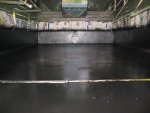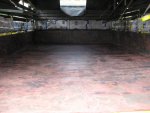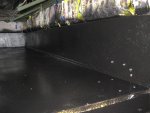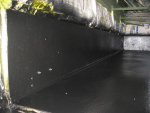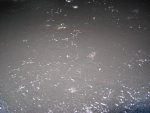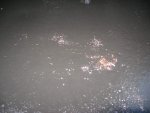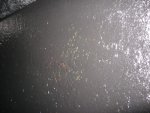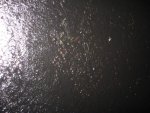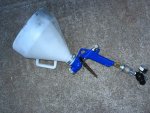UPFINN
Member
- 229
- 1
- 18
- Location
- Ishpeming Michigan
Had a major liner and primer reaction screw up yesterday while bed lining my deuce.
I sprayed rusty metal primer on the bed a few weeks ago after roughing up the paint and rust, like I did with the rest of the truck and had great results with oil enamel paint. I did not sand between the two coats of primer, as it is pretty rough, although when I thinned it more it became shiny and smooth, but you could still see a lot of "pores" in it. I don't know if the primer was supposed to be shiny or dull but I never had adhesion issues with oil enamel over the shiny primer.
Yesterday I sprayed rustoleum truck bed coating in the back. It was cheap and resists scratches better than plain oil enamel. I called customer service prior to this project and they told me putting the liner over the primer would work fine.
The truck bed coating had a severe reaction with the primer. It began to bubble right after I got done spraying the bed. A had to thin it with acetone to spray and figured that might have done it, but even un-thinned liner bubbles. It bubbles up taking a layer of primer with it. Some areas did not bubble, but the primer was compromised and I could scratch down to the carc.
I sanded the primer and tested, figuring something was wrong with the surface. The bubbling occurred, but seemed less severe.
I sanded right down through the primer into the carc and rust patina, and the liner stuck to that great.
I scraped out the liner as best as I could, and now I am debating if I should attempt to re-coat after sanding the primer, or use a chemical paint stripper to take off the liner and primer and just spray the liner over the carc. I could also prime again, spray the oil enamel, wait a year, and do the liner then after it is cured?
I have been reading about the rusty metal primer and it has mixed results with a liner top coat. A lot of users say it works great for top coating with bed liner, but they waited a few months. Others have problems like me. Since it is technically an oil enamel primer, and it takes months to cure, is it having a reaction with the solvents in the liner? I don't understand. The oil enamel paint I used had xylene in it and it did not bubble the primer even after spraying a day after priming.
If I chemically strip the bed, I might be left with clean metal and rust. What is the best cheap primer I could use for rusty metal that dries fast and could be lined after 24 hours?
I am glad I discovered this Reaction. I was going to prime the cab, then spray over the primer with ceramic sound/heat paint followed by higher quality urethane Al's Liner. I would have wasted $400. I think I might just put the Al's Liner and ceramic paint right over the old carc. There is little rust.
If anyone suggests sandblasting. That will not work. Local shop won't do it and others would cost a fortune. They won't work with carc removal.



I sprayed rusty metal primer on the bed a few weeks ago after roughing up the paint and rust, like I did with the rest of the truck and had great results with oil enamel paint. I did not sand between the two coats of primer, as it is pretty rough, although when I thinned it more it became shiny and smooth, but you could still see a lot of "pores" in it. I don't know if the primer was supposed to be shiny or dull but I never had adhesion issues with oil enamel over the shiny primer.
Yesterday I sprayed rustoleum truck bed coating in the back. It was cheap and resists scratches better than plain oil enamel. I called customer service prior to this project and they told me putting the liner over the primer would work fine.
The truck bed coating had a severe reaction with the primer. It began to bubble right after I got done spraying the bed. A had to thin it with acetone to spray and figured that might have done it, but even un-thinned liner bubbles. It bubbles up taking a layer of primer with it. Some areas did not bubble, but the primer was compromised and I could scratch down to the carc.
I sanded the primer and tested, figuring something was wrong with the surface. The bubbling occurred, but seemed less severe.
I sanded right down through the primer into the carc and rust patina, and the liner stuck to that great.
I scraped out the liner as best as I could, and now I am debating if I should attempt to re-coat after sanding the primer, or use a chemical paint stripper to take off the liner and primer and just spray the liner over the carc. I could also prime again, spray the oil enamel, wait a year, and do the liner then after it is cured?
I have been reading about the rusty metal primer and it has mixed results with a liner top coat. A lot of users say it works great for top coating with bed liner, but they waited a few months. Others have problems like me. Since it is technically an oil enamel primer, and it takes months to cure, is it having a reaction with the solvents in the liner? I don't understand. The oil enamel paint I used had xylene in it and it did not bubble the primer even after spraying a day after priming.
If I chemically strip the bed, I might be left with clean metal and rust. What is the best cheap primer I could use for rusty metal that dries fast and could be lined after 24 hours?
I am glad I discovered this Reaction. I was going to prime the cab, then spray over the primer with ceramic sound/heat paint followed by higher quality urethane Al's Liner. I would have wasted $400. I think I might just put the Al's Liner and ceramic paint right over the old carc. There is little rust.
If anyone suggests sandblasting. That will not work. Local shop won't do it and others would cost a fortune. They won't work with carc removal.







 It is some pretty tough stuff. Not the best, but better than paint. The paint stripper only took off the peeling stuff, but there still is a thin layer of rusty metal primer and carc left behind. This thin layer is very difficult to scratch or sand. It is almost like the pores and rust in the metal absorbed it. Since this test was successful, tomorrow (today) I will strip the bed down and sand it, then reapply the liner (after a small test area of course). I might roll it on or use a hopper gun. The schutz gun clogs.
It is some pretty tough stuff. Not the best, but better than paint. The paint stripper only took off the peeling stuff, but there still is a thin layer of rusty metal primer and carc left behind. This thin layer is very difficult to scratch or sand. It is almost like the pores and rust in the metal absorbed it. Since this test was successful, tomorrow (today) I will strip the bed down and sand it, then reapply the liner (after a small test area of course). I might roll it on or use a hopper gun. The schutz gun clogs.
 .
.